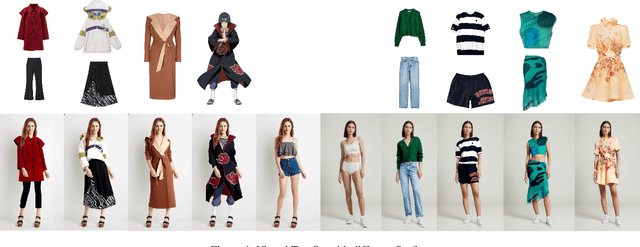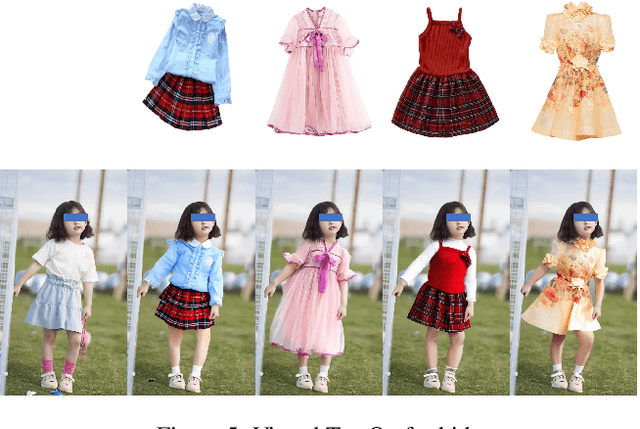Xindi Zhang
Wan-Animate: Unified Character Animation and Replacement with Holistic Replication
Sep 17, 2025Abstract:We introduce Wan-Animate, a unified framework for character animation and replacement. Given a character image and a reference video, Wan-Animate can animate the character by precisely replicating the expressions and movements of the character in the video to generate high-fidelity character videos. Alternatively, it can integrate the animated character into the reference video to replace the original character, replicating the scene's lighting and color tone to achieve seamless environmental integration. Wan-Animate is built upon the Wan model. To adapt it for character animation tasks, we employ a modified input paradigm to differentiate between reference conditions and regions for generation. This design unifies multiple tasks into a common symbolic representation. We use spatially-aligned skeleton signals to replicate body motion and implicit facial features extracted from source images to reenact expressions, enabling the generation of character videos with high controllability and expressiveness. Furthermore, to enhance environmental integration during character replacement, we develop an auxiliary Relighting LoRA. This module preserves the character's appearance consistency while applying the appropriate environmental lighting and color tone. Experimental results demonstrate that Wan-Animate achieves state-of-the-art performance. We are committed to open-sourcing the model weights and its source code.
OutfitAnyone: Ultra-high Quality Virtual Try-On for Any Clothing and Any Person
Jul 23, 2024



Abstract:Virtual Try-On (VTON) has become a transformative technology, empowering users to experiment with fashion without ever having to physically try on clothing. However, existing methods often struggle with generating high-fidelity and detail-consistent results. While diffusion models, such as Stable Diffusion series, have shown their capability in creating high-quality and photorealistic images, they encounter formidable challenges in conditional generation scenarios like VTON. Specifically, these models struggle to maintain a balance between control and consistency when generating images for virtual clothing trials. OutfitAnyone addresses these limitations by leveraging a two-stream conditional diffusion model, enabling it to adeptly handle garment deformation for more lifelike results. It distinguishes itself with scalability-modulating factors such as pose, body shape and broad applicability, extending from anime to in-the-wild images. OutfitAnyone's performance in diverse scenarios underscores its utility and readiness for real-world deployment. For more details and animated results, please see \url{https://humanaigc.github.io/outfit-anyone/}.
RenderIH: A Large-scale Synthetic Dataset for 3D Interacting Hand Pose Estimation
Sep 27, 2023Abstract:The current interacting hand (IH) datasets are relatively simplistic in terms of background and texture, with hand joints being annotated by a machine annotator, which may result in inaccuracies, and the diversity of pose distribution is limited. However, the variability of background, pose distribution, and texture can greatly influence the generalization ability. Therefore, we present a large-scale synthetic dataset RenderIH for interacting hands with accurate and diverse pose annotations. The dataset contains 1M photo-realistic images with varied backgrounds, perspectives, and hand textures. To generate natural and diverse interacting poses, we propose a new pose optimization algorithm. Additionally, for better pose estimation accuracy, we introduce a transformer-based pose estimation network, TransHand, to leverage the correlation between interacting hands and verify the effectiveness of RenderIH in improving results. Our dataset is model-agnostic and can improve more accuracy of any hand pose estimation method in comparison to other real or synthetic datasets. Experiments have shown that pretraining on our synthetic data can significantly decrease the error from 6.76mm to 5.79mm, and our Transhand surpasses contemporary methods. Our dataset and code are available at https://github.com/adwardlee/RenderIH.
Cloth2Tex: A Customized Cloth Texture Generation Pipeline for 3D Virtual Try-On
Aug 08, 2023Abstract:Fabricating and designing 3D garments has become extremely demanding with the increasing need for synthesizing realistic dressed persons for a variety of applications, e.g. 3D virtual try-on, digitalization of 2D clothes into 3D apparel, and cloth animation. It thus necessitates a simple and straightforward pipeline to obtain high-quality texture from simple input, such as 2D reference images. Since traditional warping-based texture generation methods require a significant number of control points to be manually selected for each type of garment, which can be a time-consuming and tedious process. We propose a novel method, called Cloth2Tex, which eliminates the human burden in this process. Cloth2Tex is a self-supervised method that generates texture maps with reasonable layout and structural consistency. Another key feature of Cloth2Tex is that it can be used to support high-fidelity texture inpainting. This is done by combining Cloth2Tex with a prevailing latent diffusion model. We evaluate our approach both qualitatively and quantitatively and demonstrate that Cloth2Tex can generate high-quality texture maps and achieve the best visual effects in comparison to other methods. Project page: tomguluson92.github.io/projects/cloth2tex/
 Add to Chrome
Add to Chrome Add to Firefox
Add to Firefox Add to Edge
Add to Edge